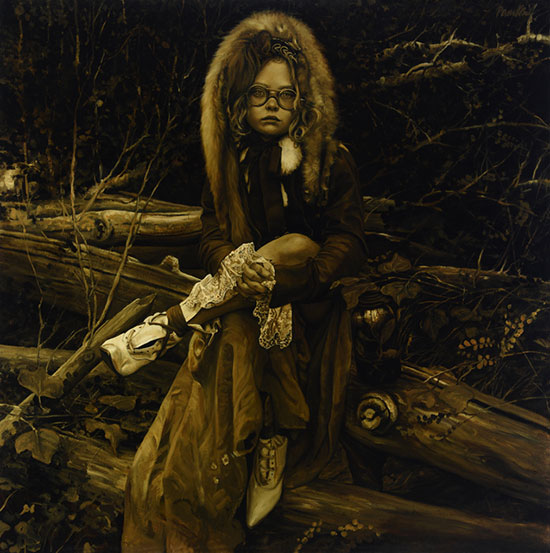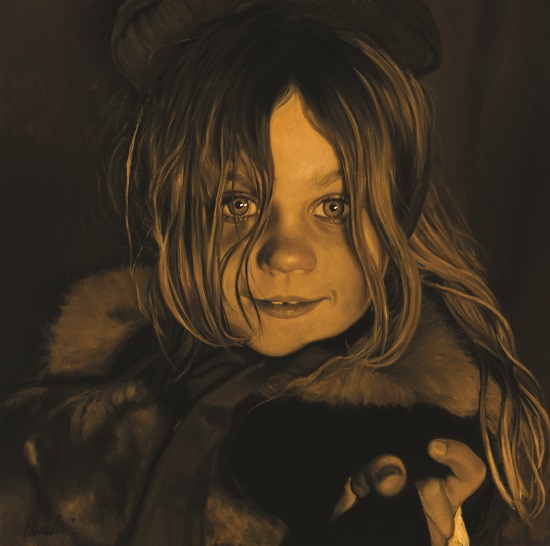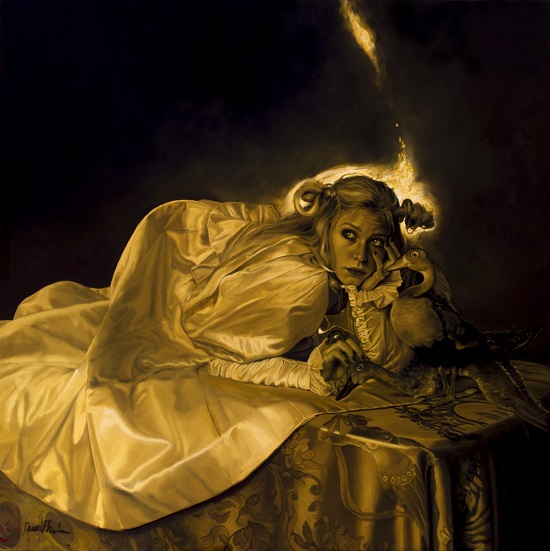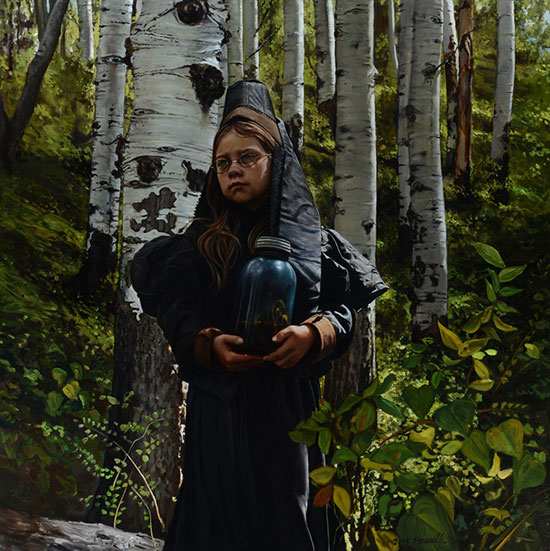People in exotic garb caught in unusual situations embracing strange objects are the mainstay of Pamela Wilson’s art. Think harlequins, taxidermy geese, clown-white faces, fur stoles, flowing gowns, dolls and oversize striped lollipops and the picture will start to form.
Frequently featuring only a solitary figure, Pamela Wilson’s painted worlds are inhabited by people who can be found along railroad tracks, in burning landscapes, dim interiors, thick woods or on desolate beaches. In some cases, the subjects are portrayed a la Hitchcock, with only a threatening sky as backdrop, or perhaps a sliver of land or mountainside for grounding. Combine these elements with a heady mix of steampunk, the macabre and a twist of unexpected lightheartedness and the journey to explore complex worlds in the paintings of Pamela Wilson can begin.
A series of Wilson’s latest paintings make up the exhibition “The Sweetest Poison” at RJD Gallery in Sag Harbor, NY The work reveals a new direction for the painter, with glitter, gold leaf and monochromatic veils incorporated for the first time to cloak the artist’s figurative magical realism.
.
.
Preparing for the solo show with the title already in place began two years ago, Wilson said in a recent interview. She originally began painting a “sweetest poison” series portraying the underworld of absinthe drinkers but then swiveled to explore a more universally experienced venom—when those closest to us choose to betray and inflict pain instead.
.
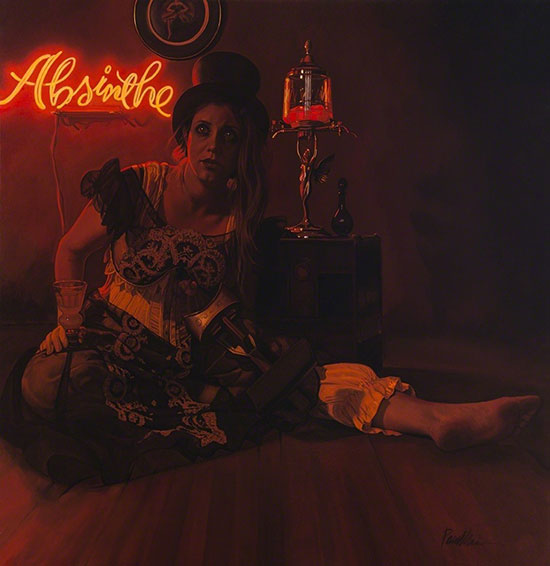
"Sweet Secrets in Bare Delirium" by Pamela Wilson, 2016. Oil on Canvas, 48 x 48 inches. Courtesy RJD Gallery.
.
In the new paintings, compositions feel like portraits instead of narrative surrealistic tableaus. Penetrating gazes and expressive poses reveal raw emotion or resolve in narrative paintings that are complex and compelling. In line with all her work, the paintings are intense, dreamlike, encourage personal engagement with meaning, and have an autobiographical connection. In a slightly different shading, here the outlandish is toned down in favor of the plausible (if still unlikely and dreamlike).
“I love this work,” the artist said. “The paintings are all very dramatic and capture, for me, the decadence of sweet poison. The reds are very dramatic. My favorite painting is Holograph Girl. It’s a positive piece. I liked the time I spent with her and bringing her into the world. I feel good about it.”
.
.
The dramatic intensity of the new work matches Wilson’s personal world at the time she created it as she grappled with a series of emotional blows. Turning outward to her artmaking, she instilled in the new paintings a reflection of her moving through traumatic times and her belief that discovering silver linings is an important and necessary part of grieving.
“My life caved in and the new work has my blood, sweat and tears in it,” she said. “I’ve accepted that I have changed. But all is not dark. I look for the spark of hope. All my work has some facet of light.”
.
.
Musing on the concept of candy that’s delicious in its sugary sweetness but at the same time harmful to the body, Wilson’s works began to sparkle or glisten from thick applications of paint that made them shine. The paintings are visually “candy coated” through monochromatic treatment or shiny or sparkling surfaces. The compositions themselves move closer to intimate portraits, channeling the kinds of real-life insights that can sometimes appear within restless dreams.
.

"Festooned Wallflower" by Pamela Wilson, 2016. Oil on canvas over birth panel 18 x 18 inches. Courtesy RJD Gallery.
.
She also began working with gold leaf, joining fellow contemporary painter Brad Kunkle, known for his photorealism with a dreamlike quality. Some of Wilson’s paintings contain captivating pools of rich textured gold that are an integral part of the magical realism compositions.
“The works shimmer with decadence,” she said. “It’s out there, but it’s still real.”
.
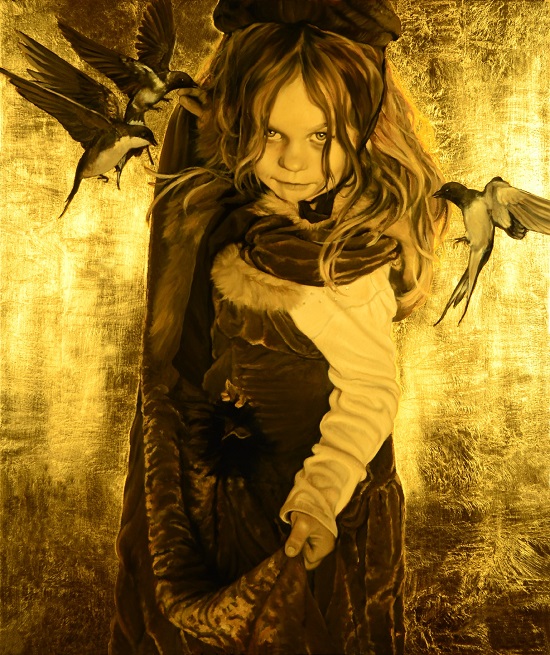
"The Incurious Came Pirouetting" by Pamela Wilson, 2016. Oil and 24K gold leaf on canvas on birch panel, 24 × 20 inches. Courtesy RJD Gallery.
.
Virtual viewing on online platforms doesn’t allow viewers to experience the way high gloss finishes catch the light in When The Wolfbane Blooms; how the thick finish sparkles and adds nuance to the despair captured in the woman’s face in Festooned Wallflower; or the expressiveness and warmth in the depiction of a child’s hand contrasted against the utter stark realism of a grove of trees in The Grievance. It is only when viewed in person that the paintings spring to life and manifest their full emotional range. Neither is Wilson’s painterly mastery apparent when her work is viewed online, as the compositions are flattened, obscuring the details and depth that make the paintings rich.
.
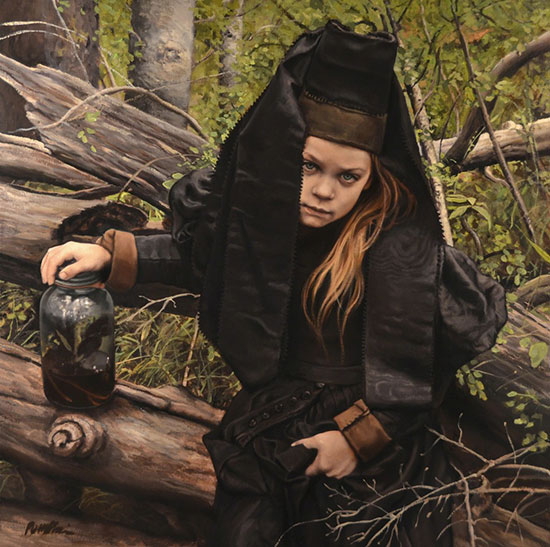
"Murmurs from the Hollow" by Pamela Wilson 2016. Oil on canvas, 24 x 24 inches. Courtesy RJD Gallery.
.
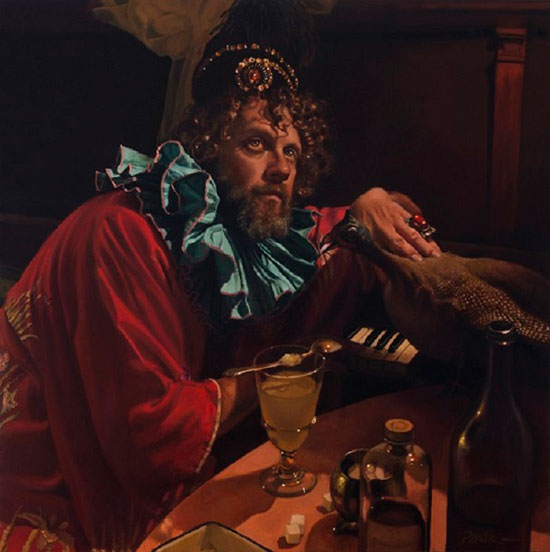
"When The Wolfbane Blooms" by Pamela Wilson, 2016. Oil on canvas over birch panel, 18 x 18 inches. Courtesy RJD Gallery.
.
Wilson’s use of glitter, monochromatic tone and gold leaf are not just part of the conceptual development of “The Sweetest Poison” as theme; these techniques reveal a painter continuing to explore her medium. An acknowledged master as a figurative and magical realism painter, Wilson found connections with contemporary realism painters Jeremy Mann and Kent Williams as guides and inspiration in her efforts to continue to move forward in her art.
“Finding the figure is something I’m really good at and it’s what I do,” she said. “How far can go you with it? That’s what I’m asking myself. Realism and painting are both tools I’ve had to make work that’s believable and that reveals something real. I need to go further as an artist. I need to have time to play and see what happens.”
.
.
Photography is one medium that allows Wilson to play, and is another important element in the artist’s approach to making her paintings.
Each piece begins with a photo shoot that’s carefully orchestrated and yet still fully spontaneous. Intuitively creating worlds that she feels keenly and wants to translate into visual storytelling, Wilson favors working with the same models repeatedly. The same preference and practice is in play in the new paintings.
For shoots, models are provided with objects of meaning for Wilson, most discovered in antique shops. Costumes pieces are put together and the model dressed for the creative encounter. Locations—crucial to her process—are scouted and selected for their atmospheric and haunting qualities. For Wilson, these locations promise magic for the creation of her surrealistic worlds and the experience she captures first with a camera and then with paint. Once everything is in place, a type of synergy occurs, leaving a lot of the outcome to chance, the artist explained.
“There’s a synesthesia that lives in these worlds and magic happens at the photo shoot,” she said. “Then I go home and execute and make it my own.”
.
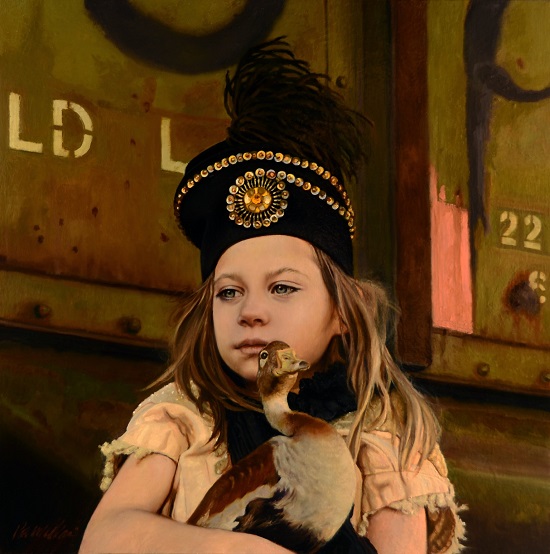
"Darksome Companions of the Dearly Decamped" by Pamela Wilson, 2016. Oil on canvas over birch panel, 18 x 18 inches. Courtesy RJD Gallery.
.
While darkness can be easy to see in Wilson’s work, there is hope as well, manifesting from inner strength and resilience, realization and acceptance. Her work can contain moments of lightness and laughter and surprise. It is this intimate pairing of experiential opposites—sweet expectations and bitter disappointment; joy and despair; tragedy and delight; mere absurdity and complete insanity—that informs the complexity of Wilson’s work and makes it so compelling.
Wilson feels her paintings explore the possibilities of extreme ranges of the emotional spectrum and the dark and light experiences that unfold on the way to the sublime. The light that guides her comes from the experiences we have along the way that help us to grow as human beings.
“We’re all part of the universe,” she said. “We all grapple with tragedy and try to decipher meaning and find out what’s important ... I see my work as part of the universe and the worlds that I’m showing have meaning and are meant to be seen as a part of it.”
.

"Pale Moths of Starless Nights" by Pamela Wilson 2016. Oil on canvas, 48 x 24 inches. Courtesy RJD Gallery.
.
_____________________________________
BASIC FACTS: "The Sweetest Poison" is on view from August 20 to October 4, 2016 at RJD Gallery in Sag Harbor. The exhibition has an Opening Reception on Saturday, August 20, 2016 from 6:30 to 8:30 p.m. The artist is expected to be in attendance. Pamela Wilson is based in California. RJD Gallery is located at 90 Main Street, Sag Harbor, NY 11963. www.rjdgallery.com.
_____________________________________
Copyright 2016 Hamptons Art Hub LLC. All rights reserved.

